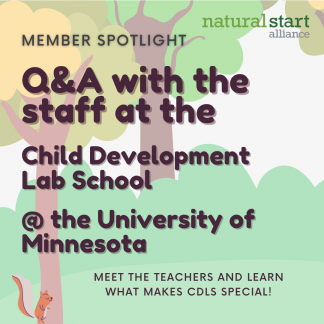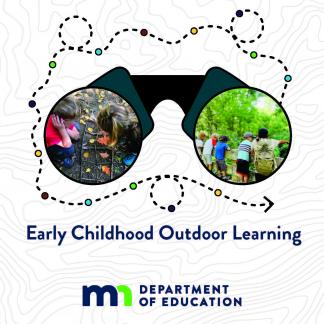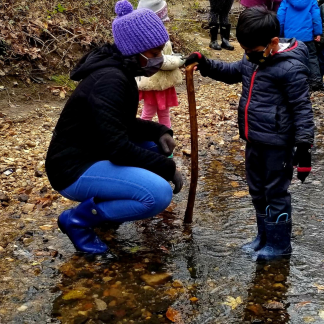Member Spotlight
Child Development Laboratory School at the University of Minnesota

For our latest Member Spotlight, we spoke with the staff at the Child Development Laboratory School at the University of Minnesota to learn more about what makes their program great. Take a few minutes to watch the video and get familiar with this fantastic program that incorporates nature-based learning and sustainability and helps prepare future educators to be the best they can be!
Special thanks to Marie Lister, Early Childhood Specialist and Assistant Director at the Child Development Lab School, for filming staff videos!
Watch the complete video below.
Transcript
If you watch the video on YouTube, you can jump ahead to any of these questions and answers.
Natural Start: Tell us about your program!
Sarah: We serve roughly 240 children and families. We have children from infancy all the way up until they go off to kindergarten. We have a wide population of families. We have some families that are in the community and some of our population is University family faculty and staff.
NS: What are the goals of the program?
Sheila: At the Child Development Laboratory School, our mission is really focused on three goals: to provide a wonderful place for children to learn; to provide opportunities for University of Minnesota students to have chances to interact with children as student workers, as student teachers, as assistant teachers, whatever capacity they’d like to grow; and to foster opportunities for research in areas of child development, or other areas where children might be present.
NS: What’s your program philosophy?
Sheila: Throughout our program, we believe that children are capable of learning lots of different things and that they are always learning. So, we use a play-based approach and we also enjoy spending lots of time outside so they get lots of hands on experiences and opportunities to build relationships with each other and with their teachers. I think that’s a core foundation of our program and of the goals that we have for children. We also support student learners here, so University of Minnesota students in our Early Childhood Department spend time in our classrooms and they also get a chance to interact with children both indoors and outdoors doing all sorts of fun activities. That’s a really core goal of our program is to help them become wonderful teachers in the future.
NS: How do you set up the learning environment?
Britney: For us, we kind of start with a minimalistic approach in our classroom and as our children come in and we get to know them and we see where their interests are, we make changes to what we put in the classroom. We’re hoping to build on their interests and their skills, bring in things that are a little more complex so that their learning goes deeper and gets more complex. We’re building on what they already know. We’re hoping that when they walk into the space that something catches their eye and pulls them in. We also hope that they can learn from each other. With all classes, children learn at different rates and so they have that advantage of learning from other children who are more mastered in a certain area.
NS: We know that sustainability is one of the values of your program. How do you incorporate sustainability into your classrooms and curriculum?
Mandy: Children just seem to be naturally interested in sustainability and taking care of their earth and their environment. And we encourage that by even just putting a small prompt like a book about water conservation in our room. [That] can cause emergent curriculum about saving water and other things that we can conserve.
One thing I do every year with every group is we learn about the honorable harvest. That is a set of guidelines authored by Dr. Robin Kimmerer. We kind of do a children’s version of it. It’s a set of rules about how you harvest from nature. The first rule being, you ask nature if you can take from it. You have to be able to observe nature and see, is there enough here to get your answer? And then we ask the children, what is nature telling you? The kids will know, there is only one flower here, we can’t take it. The next rule is “use what you take.” Maybe these aren’t in order. Use what you take, and if you take too much, share. And give back and give thanks. The way we do that is just doing kind things for nature.
NS: Tell us more about the research that takes place in the classroom!
Sheila: Throughout the years there has been lots of different types of research, but in the past couple of years since COVID and since we’ve returned from our COVID break, some of the research is really focused on children’s social and emotional development in groups with their peers.
We had one last year where all of our playgrounds for the first seven weeks of the school year had GoPros around and they were really looking at how children are returning to groups and group care after a long time of being in smaller pods or even isolated from their peers. So, there are studies about that.
We have some that focus on other social-emotional areas like apologies and how children show relationship building skills. We have some about air quality because it’s COVID and so they’ve been doing measurements like that.
We welcome a lot of different types of research here at the Lab School because we want to help foster the understanding of who children are as people.
NS: How do you prepare students, teachers, and parents for outdoor play in cold weather?
Amy: We start by being really informative with families about the types of clothing that they can dress their children in, with a lot of priority around layering and having great base layers even on the hands and feet having a liner glove or a liner sock underneath the other warmer layers on top. [We emphasize] the importance of waterproof outer layers when there is snow so that none of the moisture gets in and causes discomfort and chilliness. We try to set [parents] up for success in feeling confident that they know how to dress their children appropriately for the cold.
We also, as teachers, will communicate with families about any cutoffs that we have and really be explicit about where those cutoffs are so that they know what to expect on a given day, especially if it is bitterly cold. We do spend a lot of time outside, even when it seems to everyone else that it’s bitterly cold and it seems somewhat unsafe, [we know] that it isn’t and we know why and we can share that clearly with them, those cutoffs for risk of frostbite and things like that so they know we are not just staying outside just to stay outside but that there are these charts that we follow to make sure that we are being as safe as possible and staying inside the number of minute ranges to minimize any exposure.
We are also, as teachers, dressing appropriately ourselves so that we can stay present in the moment and focused on our teaching and focused on attending to the children and making sure that they are warm enough. Not all children can communicate to us that they are cold, so that means that we have to be that safety measure for their sake, where we are checking in on them, taking off their gloves and making sure that their hands are feeling warm, checking their cheeks, and making sure that exposed skin is covered – things like that to make sure everyone is safe.
And also making sure that everyone is staying active. We do a lot of active play in the winter and that is something that is really great about the snow. [Snow] just encourages that kind of active play that generally keeps kids warm from the inside out.
We do take breaks from time to time if we need a little bit of a warm up before we go back out. We provide lots of warm beverages to keep them warm. We might even build a fire as a class as another way to provide a heat source outside
NS: What are some of your favorite activities to do outside in winter?
Peter: In the wintertime, our class likes to go exploring and see how our body moves in the new environment with snow and all of our snow gear on. We enjoy running and playing with the snow as well as doing some art projects.
Britney: I love being out with the kids. They love real work! So, doing real work with them, whether it’s shoveling snow, or building something, or using the snow as food, they just love to do real work. I don’t know, I love everything about winter! Like the crunch of snow under your feet when your walking and just getting them excited. When they see you excited, they get excited.
Amy: There are many – the snow provides a lot in terms of curriculum. We can pile it up and make forts that we can dig out. We can build our own playground equipment with snow and makes slides and stairs and mountains to wrestle on. We often times will use colorful water to spray on to the snow and decorate it. We freeze it into ice. There are so many opportunities for science explorations with the cold. We do a lot of sledding. You don’t need to have to have a hill in order to enjoy sleds with children, they love pulling each other and it fosters really great connections between them. There are places that are slippery and we can skate on our boots. It’s a lot of cooking and making food with snow. I just feel it’s almost endless possibilities, the things that you can do with snow. So, I just kind of embrace it.
NS: We’d love to know more about the role that teacher candidates play in the classroom!
Ayuko: The teacher candidates come in with different backgrounds and experiences. For us teachers, it’s a really wonderful experience to see how they work with children and it helps us reflect on how we do as teachers modeling for them and the best practices that we give them. We also believe in this experience with the nature-based approach that as they are learning how to teach children outside that they can use materials such as the natural materials as part of the ways to enrich their curriculum and experiences.
At CDLS we hope [student teachers] learn how to work collaboratively with us lead teachers as well as their cohort and their fellow colleagues. And really learn how to be creative as they learn how to work with and play with children outside and inside.
NS: What’s your favorite part about teaching and working at CDLS?
Kim: My favorite part about being teacher is watching how children make connections everyday. Whether that’s with their environment, with their peers, with other teachers that they are seeing. The connections that they are making are things that will follow with them the rest of their lives.
Kelli: My favorite part about being a teacher is watching the children come into the room and then grow and mature and develop into their own person with their own thoughts and feelings and just seing them become their own person. And watching the parents go, “Wow! I didn’t know they could do that,” or “Wow, they’re amazing!” I just love seeing how competent they are when people don’t give them enough credit for their competency.
Emma: I really enjoy working at CDLS. I love all of the diversity we have and all of the opportunities that they children get to learn and grow here.
Erin: What I like most about teaching is the connection, the learning connections that children make after doing the same thing for a long amount of time. And watching they smile everyday and be happy!
Lily: What I love most about working at CDLS is that everyone who walks through this door has the same goal: we want to show love and respect for the children the best way possible.
Heather: I love everything about this building. I’ve been here a really long time and I just can’t leave – it’s my favorite place. I love the children, the parents, the staff. I have longtime lasting friendships with a lot of people through the years and it’s so great to build that sense of community and to be able to love where you work.
Participating CDLS Staff:
- Sheila Williams Ridge, Co-Director
- Sarah McKee, Co-Director
- Marie Lister, Assistant Director
- Lily Bray, Administrative Specialist
- Amy Betz, AM Lead Teacher
- Ayuko Uezu Boomer, AM Lead Teacher
- Peter Locast, PM Lead Teacher
- Britney Stark, Teacher
- Emma Chandler, Assistant Teacher
- Heather Doughty, Assistant Teacher
- Erin Gorski, Teacher
- Kelli Kern, Teacher
- Kimberly Reis, Teacher



